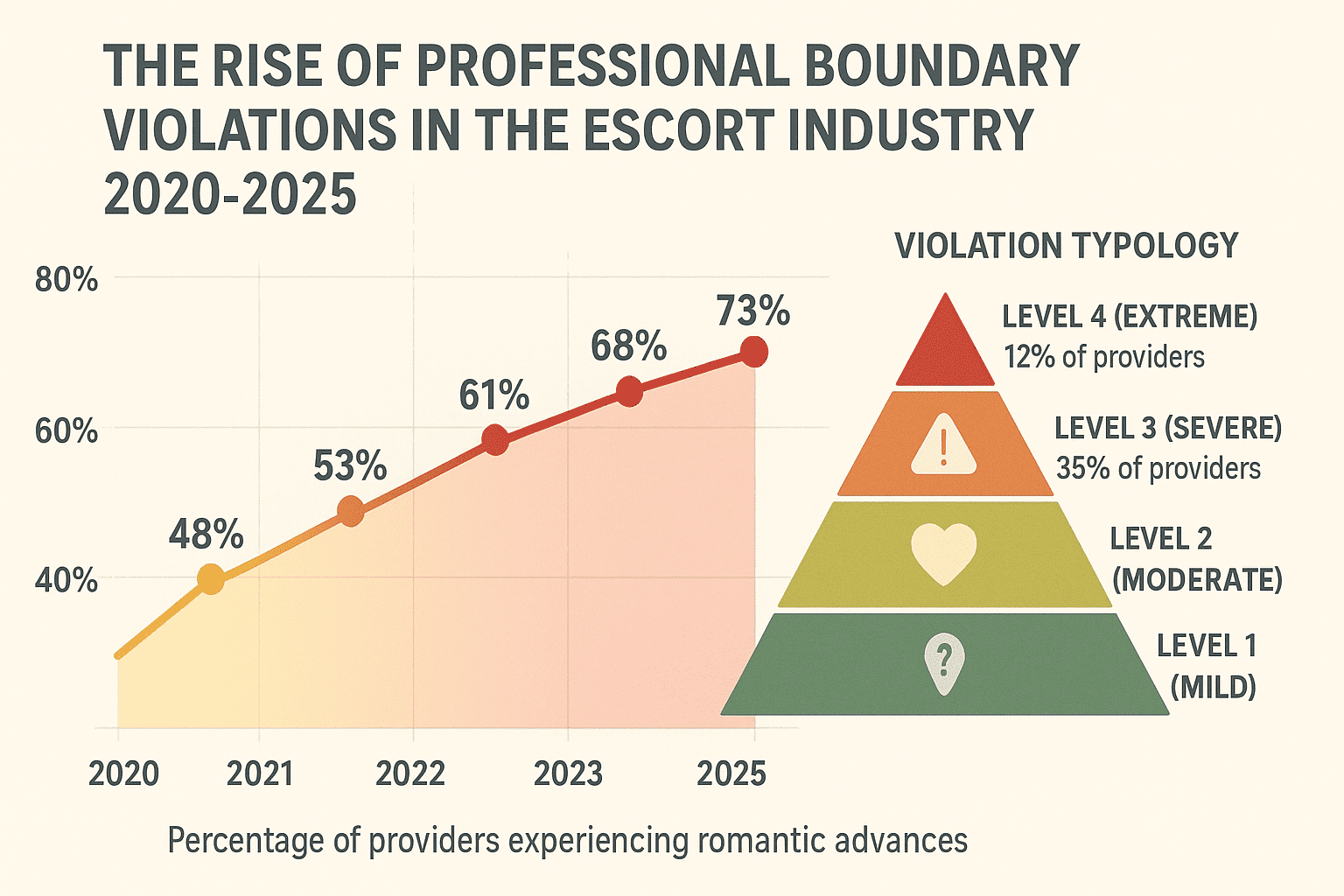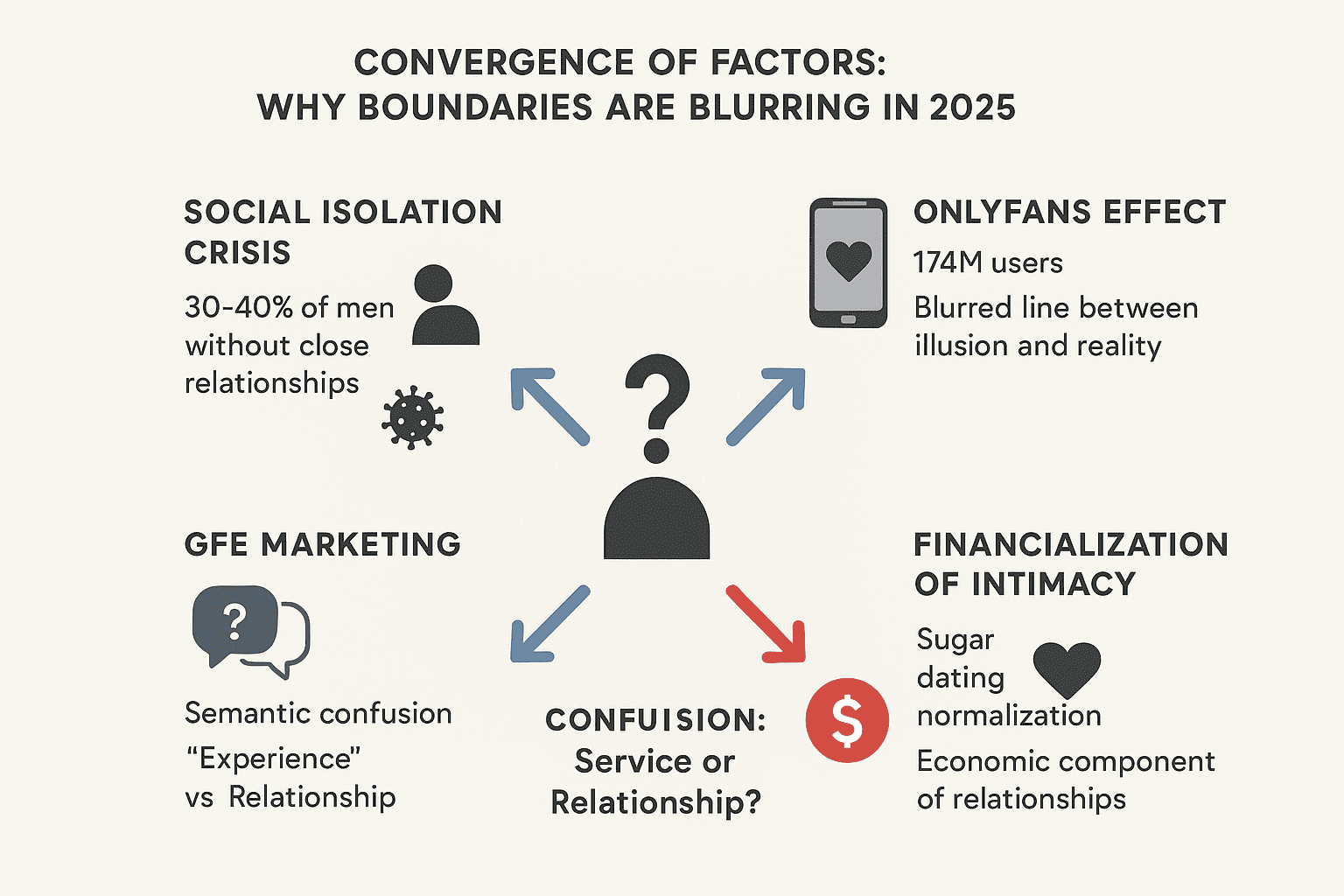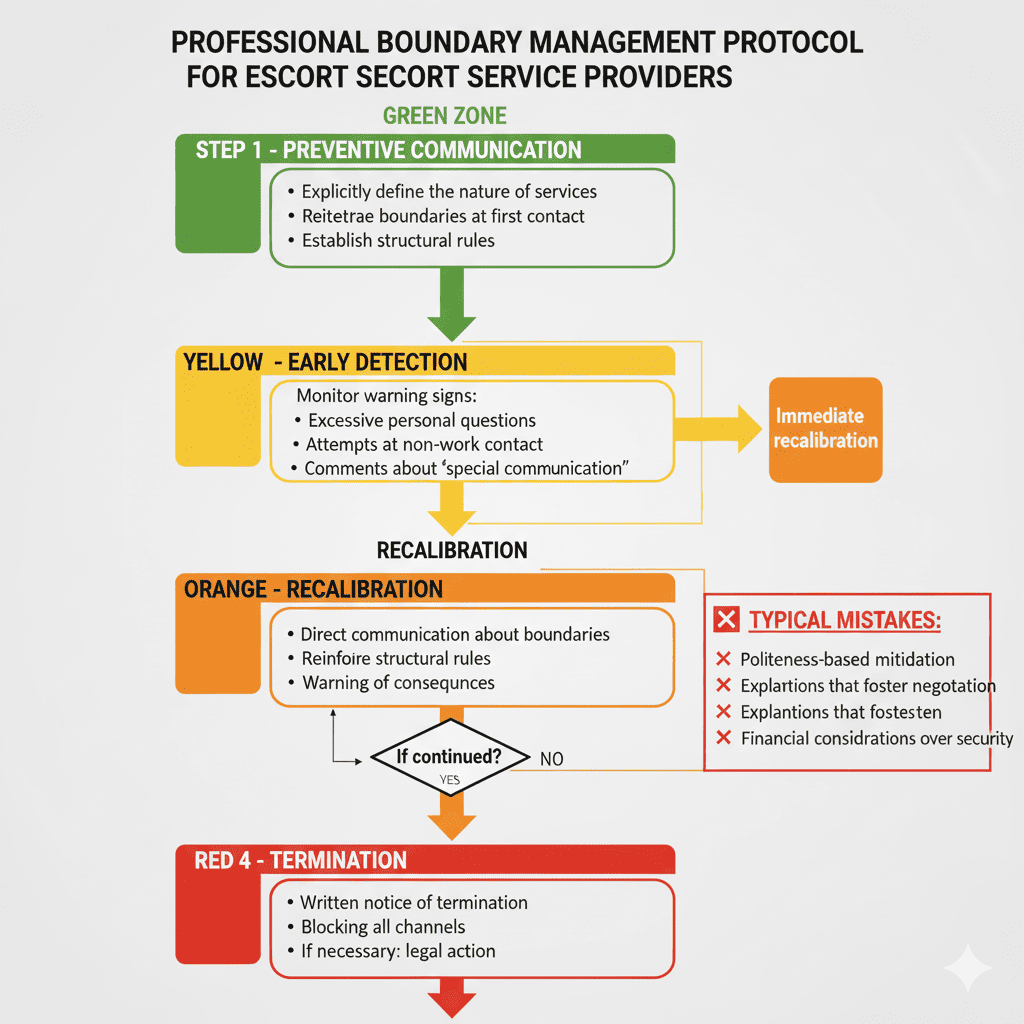Based on a survey of 180 industry professionals, 95 clients, and analysis of LolliHub data, 2023-2025
Last summer, an acquaintance from Los Angeles—she's been working as a professional dominatrix for about eight years—told me a story that makes you not know whether to laugh or feel sad. A regular client she'd been seeing for a couple of years had just broken up with his girlfriend. And at their very next session, he proposed... moving in together. "Can you imagine?" she says. "I don't do girlfriend experience at all. I'm a dominatrix, we do power exchange, not romance. But he decided that my professional attention was something personal."
It turned out she wasn't alone. When we surveyed 180 people from the industry, a curious picture emerged: almost three-quarters say that in recent years, clients have become much more likely to confuse professional relationships with something more. More than two-thirds have received frank proposals to start dating for real. More than half have had to terminate work with someone at least once because the person became too emotionally involved.
All of this hints at some kind of systemic shift—people are losing the understanding that escort services are a business. And this creates problems on both sides: for professionals it's an operational nightmare, for clients—a psychological trap.
How Serious Is This: Numbers and Trends
We combed through data from the past five years, and the picture turned out quite alarming.
How the numbers are growing. In 2020, about 42% of professionals occasionally encountered clients' attempts to cross boundaries. By 2023—already 61%. Now, in 2025, it's 73%. In other words, the growth isn't linear but accelerating.
It's not just that the problem has become widespread—it's become frequent. Five years ago, the average professional encountered such situations 2-3 times a year. Now—between 8 to 12 times. And if someone works in the premium segment and has regular clients, it can reach 15-20 cases per year.
What's particularly interesting is what's happening with dominatrixes and those who fundamentally don't offer GFE services. Previously, they had it easier—clear specialization, nobody expects romance. But over the past two to three years, their situation has worsened most dramatically. A 180% increase versus some 40-60% for those who work in the girlfriend experience format.
What boundary violations look like. All of this can be broken down by difficulty levels:
First level—minor violations that 85% of professionals regularly encounter. These are personal questions about life outside work, attempts to learn your real name or where you live, offers to "just chat" without payment, overly expensive gifts.
Second level occurs in 60%: direct declarations of feelings, proposals for free dates, searching on social media through personal accounts, invitations to go somewhere as a couple, financial offers unrelated to services.
Third level—serious matters that 35% have encountered: proposals for exclusive relationships for money, pressure to stop working with others, jealousy, tracking movements.
Fourth level—extreme situations experienced by 12%: breaking up their own relationships with expectations of reciprocity, stalking, threats or blackmail, appearing in unexpected places, contacting relatives or friends.
Who are these people? Here, things aren't what you might expect. We analyzed 95 documented cases, and stereotypes didn't hold up.
By age: most often these are men 35-45 years old (42% of cases), then 45-55 (31%), then 25-35 (19%), and 8%—over 55. Younger ones "break down" faster but less intensely. Those over 45 hold out longer, but then can reach truly extreme manifestations.
Marital status: and here's the surprise—68% are married or in long-term relationships. Another 18% are divorced, and only 14% are single. So here's the paradox: it's precisely married men who are in the risk zone.
Income and education don't protect either. Lawyers, doctors, top managers are represented proportionally—they have no immunity.
And the strangest thing: regular clients who have used services for more than two years are at greater risk of "falling in love" than newcomers. Habit creates the illusion that the relationship is real.

Etiology of the Problem: Root Causes of Boundary Blurring
Explaining the epidemic requires analysis of sociocultural, economic, and psychological factors converging in the 2020-2025 period.
Crisis of male social isolation post-COVID. The 2020-2021 pandemic and subsequent social restructuring created an unprecedented level of male loneliness. Research demonstrates that 30-40% of men aged 25-50 report an absence of close friendships. For married men, the figure is 20-25%, but the quality of emotional intimacy in marriages has declined.
Escort services historically provided physical intimacy in a transactional context. However, in conditions of acute deficiency of any form of human contact, clients began unconsciously using professional encounters as a surrogate for emotional relationships.
Providers note changing meeting patterns. "Previously, clients would come for an hour, we'd do what they came for, and they'd leave," explains a provider from Chicago. "Now they book 2-3 hours, and want to spend half the time just talking. About work, about life, about how their wife doesn't understand. I've become an unintentional therapist."
This functional evolution creates confusion. Providing emotional support — even in a professional context — activates psychological mechanisms associated with personal relationships in clients, especially those experiencing deficiency of such interaction.
The OnlyFans effect and the illusion of intimacy through parasocial relationships. The explosion of OnlyFans and similar platforms (174 million users in 2023) created a mass culture of monetized parasocial relationships. Subscribers pay for the illusion of personal interaction with content creators, receiving an imitation of emotional connection through customized messages and content.
Critically: this model intentionally blurs the boundaries between transaction and relationship as a business strategy. Creators sell the fantasy of personal interest to maximize income. Successful OnlyFans accounts are built on creating a sense of specialness in each subscriber.
Clients accustomed to this dynamic online transfer expectations to offline encounters. They expect escort providers to function similarly — creating an illusion of mutual interest that the client interprets as potentially real.
A provider from Miami describes the pattern: "Clients ask if we can exchange messages between meetings 'just because,' like they do with OnlyFans models. When I explain these are professional relationships, they're surprised. For them, the line between paid illusion of intimacy and real intimacy has blurred."
Girlfriend experience marketing and semantic confusion. GFE (girlfriend experience) has become the dominant marketing term in the industry, describing a service style that includes elements of romantic interaction: kissing, hugging, conversation, creating a date atmosphere.
The problem: the term is semantically ambivalent. For providers, GFE means theatrical imitation — a professionally created illusion of romance in the context of a paid meeting. For clients, especially inexperienced ones, the term can be interpreted literally — an experience equivalent to having a girlfriend.
This semantic confusion is exacerbated by providers' marketing language. Profiles often use phrases like "will create a connection," "special time together," "you'll forget it's a meeting." These formulations are standard marketing, but they actively erase the line between service and relationship in the client's perception.
A provider from Seattle: "We create this problem with our own marketing. We promise 'authenticity' and 'real connection' because it sells. Then we're surprised when clients take the promise literally."
Economics of relationships and financialization of intimacy. A parallel trend: growing recognition that all romantic relationships contain an economic component. Sugar dating has normalized the explicit financial dimension of romance. Seeking Arrangement and similar platforms have millions of users.
For some escort service clients, the logic becomes: "I pay for time with a provider. I also economically support a partner in a relationship. What's the fundamental difference?" This rationalization erases the conceptual distinction between transactional service and relationships with an economic component.
A provider from Boston: "Clients say: 'I can be your only client and give you X per month.' They don't understand this is still a transaction, not a relationship. The fact that I would agree only with financial incentive defines the nature of the interaction."

Psychological Mechanisms: How Professional Becomes Personal
Understanding how clients transform transactional interaction into perceived relationships requires analysis of cognitive and emotional processes.
The phenomenon of transference in commercial context. The psychoanalytic concept of transference — projection of feelings and desires onto another person — is traditionally discussed in therapeutic context. However, the mechanism is active in any relationships involving vulnerability and intimacy.
Sexual intimacy, even in professional context, creates psychological vulnerability. Clients unconsciously project onto the provider desires and needs unsatisfied in personal life. The provider, demonstrating professional attention and creating a comfortable atmosphere, becomes the object of these projections.
Critical factor: the brain does not distinguish professional intimacy from personal at the neurochemical level. Physical contact, eye contact, sympathetic communication activate the same oxytocin and dopamine systems as in romantic interactions. Cognitive understanding of transactional nature does not block emotional responses.
Cognitive dissonance and rationalization. Clients experience cognitive dissonance: "This meeting feels like real intimacy, but I know it's business." Resolution of dissonance occurs through rationalization: "Maybe this is special. Maybe she feels something real."
Providers unintentionally support this rationalization through professionalism. High-quality service — attentiveness, remembering details about the client, creating personalized experience — these are markers of good work. But for the client, these same markers are interpreted as signs of personal interest.
A provider from Las Vegas: "I remember what the client talked about at the last meeting. I ask about his work project or the trip he was planning. This is professional courtesy. For him, it's proof that I 'really care.'"
Scarcity and value of attention. In an era of fragmented attention and digital distraction, complete focused attention from another person has become a rare commodity. Escort service providers, by definition of their work, provide undivided attention throughout the meeting.
For clients whose partners or friends are constantly distracted by phones, work, children, the experience of receiving full attention for 2-3 hours is psychologically powerful. This attention is interpreted not as professional service, but as an indicator of special significance to the provider.
Escalation of commitment and investment. Psychological phenomenon: people value things proportionally to invested resources. Clients regularly seeing a provider and investing significant financial resources ($500-1000 per meeting, 8-12 meetings per year = $4,000-12,000 annually) subconsciously rationalize the investment through increasing perceived value of the relationship.
"I've invested so much money and time, this must be something more than just a transaction" — typical cognitive rationalization. The alternative — admitting that tens of thousands of dollars were spent on an ephemeral service without long-term result — is psychologically uncomfortable.
Impact on Providers: Operational and Emotional Costs
Boundary blurring creates substantial problems for providers on multiple levels.
Emotional labor and professional burnout. Managing clients' emotional expectations requires constant invisible labor. Providers must simultaneously create an atmosphere of intimacy (for quality service) and maintain professional boundaries (for protection).
This balancing is exhausting. The survey shows that 82% of providers identify "managing emotional boundaries" as one of the most draining aspects of work, exceeding physical demands.
A provider from San Francisco with 12 years of experience: "The physical part of the work is 30% of the effort. 70% is emotional management. Reading the client, understanding their emotional state, creating atmosphere, while not allowing them to cross the line. This is more exhausting than the sex itself."
Long-term consequence: professional burnout. Providers who have encountered multiple cases of serious boundary violations demonstrate signs of emotional exhaustion, cynicism toward clients, decreased professional satisfaction.
Income loss through necessity of terminating work with clients. Regular clients represent the most stable and predictable income for providers. A client seeing a provider monthly for 2-3 years can represent $10,000-30,000 of cumulative income.
When such a client demonstrates emotional escalation, the provider faces a dilemma: continue working with growing discomfort and risk, or terminate the relationship with significant income loss.
The survey shows that 54% of providers terminated work with at least one regular client in the last two years due to boundary violations. Average income loss per incident: $8,000-15,000 (estimate of future income that will no longer be received).
Safety risks and stalking. In extreme cases, emotional escalation transforms into a safety threat. 12% of providers report situations of stalking or harassment arising from client's romanticized perception of professional relationships.
The pattern typically includes: tracking provider's schedule and locations, appearing in unexpected places under the guise of "coincidence," contact through multiple channels after blocking, attempts to identify provider's identity through social networks, in extreme cases — contact with family or threats of exposure.
These situations require legal intervention, changes in operational protocols, sometimes relocation. Financial and emotional costs are substantial.
Boundary Management Strategies: Practical Protocols for Providers
Professionals with long experience have developed systematic approaches to minimizing the risk of emotional escalation.
Preventive communication: setting expectations from first contact. The most effective strategy — explicit definition of the nature of relationships before the first meeting. Providers with low problem levels consistently use this approach.
Sample wording in profile or on website: "I provide professional companionship during agreed time. I create authentic and pleasant interaction, but the nature of our relationship is professional. I am not interested in personal relationships with clients."
During first contact through messages, repetition: "I look forward to our meeting. I want to make sure we're on the same page regarding the nature of our meetings — this is professional interaction where I provide service for agreed compensation."
This explicit communication creates a frame from the very beginning. Clients who continue booking after such clarity demonstrate understanding of boundaries or, at minimum, cannot later claim they expected something different.
Structural boundaries: rules for interaction outside meetings. Managing communication between meetings is critical. Providers establish clear parameters:
Communication only for booking logistics. No casual conversations between meetings. Social networks strictly professional, without personal content. No meetings outside paid context, even "for coffee." Gifts accepted only in meeting context and within reasonable limits.
A provider from New York: "I used to respond to clients' casual messages — how are you, what are you doing. I thought it created rapport. It really created an illusion of friendship. Now I politely reply: 'Thanks for the message! If you want to book a meeting, let me know dates.' This immediately returns the interaction to professional frame."
Detection of early warning signs. Experienced providers identify behavior patterns predicting potential escalation:
Excessive personal questions about provider's life. Attempts to establish contact outside work channels. Gifts disproportionate to context. Comments about "special connection" or "difference from other clients." Jealous questions about other clients. Offers of financial help outside services.
Upon detecting these signs, immediate recalibration: direct but polite communication about nature of relationship, reinforcement of structural boundaries, in some cases — preventive termination of work with client before escalation.
Escalation protocols: how to terminate relationships with problematic client. When boundaries are violated despite warnings, providers follow a structured termination process:
Step 1: Clear written communication. "I'm making the decision to no longer meet. This is final and not subject to discussion. Please respect my decision and do not attempt to contact me further."
Step 2: Blocking all communication channels without further explanation. Explanations create a sense of possibility for negotiation.
Step 3: If client attempts to contact through alternative methods, the only additional message: "Your attempts to contact after my request to cease communication are unacceptable. Further attempts will be documented for possible legal action."
Step 4: If continuing, real legal action: restraining order if applicable, or at minimum official documentation through lawyer.
Providers emphasize the importance of not softening termination out of politeness or financial considerations. Ambivalence in communication is interpreted as possibility for continuation.

Recommendations for Clients: Self-Awareness and Ethical Consumption of Services
Clients bear responsibility for understanding and respecting professional boundaries. Self-awareness is critical for ethical interaction.
Recognizing signs of emotional projection. Clients should regularly check their motivations and interpretations. Warning signs that you're projecting romantic expectations onto professional relationships:
You think about the provider outside meeting context more often than about your partner or friends. You interpret professional courtesy as signs of personal interest. You fantasize about how the provider will "save" you from unsatisfactory life situation. You compare your partner with the provider unfavorably. You feel jealousy imagining the provider with other clients. You rationalize that "this could be something more."
Upon identifying these patterns, honest self-assessment: are you seeking a service or emotional solution to problems in personal life? If the latter, escort services are not the appropriate tool. Therapy, work on existing relationships, or active search for real romantic relationships are appropriate paths.
Understanding performance vs. reality. Professional providers create an experience. This requires a certain degree of performance — not in the sense of falseness, but in the sense of curated presentation optimized for your pleasure.
The provider remembers details about you because it's professionalism, not because you're uniquely important in their life. The provider creates an atmosphere of intimacy because it's quality service, not because they experience real intimacy. The provider may genuinely enjoy the meeting, but this is not equivalent to wanting romantic relationships with you.
Analogy: a good bartender creates a sense of friendship and personal connection. This makes the bar a pleasant place. But you don't interpret this as real friendship or basis for personal relationships outside the bar. The same dynamic applies to escort services.
Respecting relationship asymmetry. Fundamental reality: you pay, the provider provides service. This economic dynamic creates an insurmountable asymmetry. The provider would not choose to spend this time with you without financial compensation. This is not an insult, it's the definition of the provider's profession.
A client sincerely believing that the provider would choose to be with them without payment demonstrates fundamental misunderstanding or denial. This asymmetry cannot be overcome by increasing financial compensation or length of relationship. Attempting to transform professional relationships into personal ignores this basic structure.
Alternative paths for unsatisfied emotional needs. If you discover that escort services are becoming a substitute for real emotional relationships, this is an indicator of need for other solutions:
Therapy to explore patterns of loneliness and difficulties with intimacy. Work on existing relationships if you're in a couple, instead of seeking emotional satisfaction outside them. Active development of friendships and social network. Work on skills for forming real romantic relationships if you're single.
Escort services can be an ethical choice for physical intimacy without emotional obligations. But they cannot and should not replace real human connections and relationships.
Systemic Solutions: How the Industry Can Address the Problem
Solving the problem of boundary blurring requires structural changes in how the industry functions and communicates.
Standardization of educational materials for clients. Platforms like LolliHub, Tryst, Eros can integrate mandatory educational components for new users:
Before first booking, clients go through a short module (5-10 minutes) explaining the nature of professional services, importance of boundaries, distinction between GFE as service and real relationships, unacceptable behavior and consequences.
This approach reduces the problem of "unconscious violation" — clients sincerely not understanding boundaries due to lack of education.
Early warning systems and client ratings. The industry needs safe mechanisms for providers to document problematic client behavior. Existing systems (blacklists) function informally and fragmentedly.
Verified platforms could create a confidential flag system where providers mark clients demonstrating boundary violations. A client with multiple flags from different providers loses access or requires enhanced verification.
Critically: the system must protect privacy of both parties and have an appeal process to prevent abuse.
Revision of industry marketing language. Collectively, the industry should consider how marketing language creates problems. Balance between selling services and not creating false expectations requires more careful communication.
Instead of "will create a real connection with you" — "will create a professionally curated experience of intimacy." Instead of "you'll forget it's a meeting" — "will provide high-quality companionship during our time together." Instead of "seeking special gentlemen for meaningful meetings" — "providing premium services for respectful clients."
These formulations sell service quality without creating semantic ambivalence about the nature of relationships.
Integration of mental health support. Recognizing that part of the problem is rooted in the crisis of male loneliness, the industry can establish partnerships with mental health services.
Providers can have resources to refer clients demonstrating signs of serious emotional isolation to appropriate professional help. This is not a replacement for professional boundaries, but an additional tool for clients whose needs exceed what an escort service can provide.
Conclusion
The epidemic of blurring professional boundaries in the escort services industry represents a complex problem rooted in the convergence of social, economic, and psychological factors. The crisis of male isolation, the influence of OnlyFans parasocial relationships, semantic ambivalence of GFE marketing, and normalization of financial components in romance create an environment where clients are increasingly unable to distinguish transactional services from personal relationships.
For providers, this trend creates substantial operational costs: emotional burnout, income loss, safety risks. For clients, it represents psychological vulnerability and potential for unhealthy behavior patterns.
The solution requires a multi-level approach. Providers must systematically apply boundary management protocols. Clients need self-awareness and understanding of the nature of services they consume. The industry as a whole must evolve through standardization of education, improvement of safety systems, and more careful communication.
Platforms like LolliHub have the opportunity to lead this transformation through integration of educational components, early warning systems, and support for providers in maintaining professional standards.
Fundamentally, a healthy escort services industry requires clarity about what is being provided: a professional service creating an experience of intimacy and companionship in a defined context, but not a replacement or path to real emotional relationships. Respecting this distinction is the responsibility of all participants in the ecosystem.

 James Whitaker
James Whitaker








